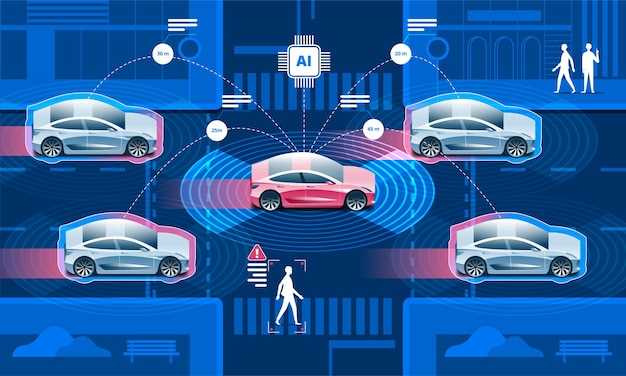
As the automotive industry continues to evolve, the integration of AI technologies into cars is transforming the landscape of transportation. These innovations are not merely enhancements; they are foundational changes that redefine how vehicles operate and interact with the world. The rise of autonomous driving, fueled by advanced artificial intelligence, promises to make our roads safer, more efficient, and accessible to all.
At the core of this revolution is the ability of AI to process vast amounts of data in real-time, allowing cars to make informed decisions based on their surroundings. This capability is crucial as vehicles navigate through complex environments, avoiding obstacles and responding to unpredictable scenarios. The result is a new level of autonomy that was once thought to be a distant dream.
Moreover, the collaboration between AI and sensor technologies enhances the overall driving experience. From LiDAR systems to computer vision algorithms, these tools enable cars to perceive their environment with remarkable precision. As we delve deeper into these innovations, it becomes clear that artificial intelligence is not just an accessory but a central pillar supporting the future of autonomous driving.
Real-time Data Processing Algorithms for Self-Driving Systems

Real-time data processing algorithms are essential for the effective functioning of autonomous driving systems in modern cars. These algorithms enable vehicles equipped with AI to analyze vast amounts of data instantaneously, ensuring safety and efficiency on the roads.
Self-driving cars rely on several types of data sources, including:
- Sensors (LiDAR, cameras, radar)
- GPS and mapping data
- Vehicle-to-everything (V2X) communication
To process this data, various algorithms are employed:
- Sensor Fusion Algorithms: These algorithms combine data from multiple sensors to create a comprehensive view of the vehicle’s environment. This approach helps in improving object detection and classification, making the AI smarter and more reliable.
- Path Planning Algorithms: These enable the vehicle to determine the best route to its destination by analyzing real-time traffic data and road conditions. By using AI, these algorithms adapt to changing environments, providing dynamic routing solutions.
- Machine Learning Algorithms: Deep learning techniques are utilized to enhance the vehicle’s ability to interpret complex data patterns. This includes recognizing pedestrians, road signs, and unexpected obstacles, which is crucial for safe navigation.
- Predictive Modeling Algorithms: These algorithms forecast the behavior of other road users, such as predicting the actions of pedestrians or other vehicles. This foresight is vital for making real-time decisions to prevent accidents.
The integration of these algorithms not only improves the performance of self-driving cars but also elevates the overall user experience by ensuring a smooth and safer journey. As AI continues to evolve, the capabilities of real-time data processing will expand, making autonomous systems even more robust and efficient.
Safety Measures and Ethical Considerations in AI-driven Vehicles

As the development of self-driving vehicles accelerates, safety measures and ethical considerations become paramount in the implementation of AI technologies. First and foremost, manufacturers must prioritize the reliability of their AI systems. This includes extensive testing in diverse conditions to ensure that self-driving cars can handle various road scenarios, weather changes, and unpredictable human behaviors effectively.
Additionally, regulatory frameworks need to evolve alongside technological advancements. Governments must establish clear guidelines that dictate how AI algorithms are developed, tested, and deployed. This includes mandatory reporting of accidents involving autonomous vehicles to facilitate learning and improvements in AI systems, thereby enhancing safety protocols.
Ethically, the decision-making process of AI in critical scenarios–such as accidents–raises significant dilemmas. Developers must program self-driving cars with algorithms that can prioritize human life effectively and make decisions that align with societal values. This requires comprehensive engagement with ethicists, policymakers, and the public to design AI systems that reflect a collective moral compass.
Furthermore, transparency in AI decision-making processes is crucial. Individuals must understand how their self-driving vehicles operate and the considerations behind the decisions made by the AI. This transparency can build trust and facilitate a smoother integration of autonomous vehicles into society.
Finally, addressing data privacy is essential. AI-driven vehicles continuously collect and analyze data to improve their functionality. Manufacturers must safeguard this information and ensure that user privacy is respected. Robust cybersecurity measures must be implemented to prevent unauthorized access and misuse of sensitive data.
Integrating Machine Learning for Improved Navigation and Traffic Management
The integration of AI technologies, particularly machine learning, is revolutionizing the navigation systems in cars and enhancing traffic management. Machine learning algorithms, which can learn from vast amounts of data, allow autonomous vehicles to adapt to dynamic road conditions and optimize their routes effectively.
By analyzing historical and real-time traffic data, machine learning can predict congestion patterns and identify the fastest routes for vehicles. This not only improves the efficiency of navigation systems but also reduces travel time. Autonomous cars equipped with advanced machine learning models can utilize this data to make informed decisions that enhance the overall driving experience.
Moreover, machine learning enables better communication between autonomous vehicles and traffic management systems. Through data-sharing protocols, these systems can communicate vital information such as traffic signals, road hazards, and construction zones. This integration helps in mitigating traffic bottlenecks and increases overall road safety.
In addition to navigation, machine learning plays a crucial role in developing adaptive traffic signal systems. By processing real-time vehicle counts and flow rates, these systems can adjust signal timings to improve traffic flow, thereby reducing wait times at intersections. The adaptive management of traffic light systems leads to smoother transit for all types of vehicles, including AI-driven cars.
Furthermore, machine learning models can enhance the predictive maintenance of infrastructure, identifying wear and tear on roads and traffic signals before they become problematic. This ensures that necessary repairs are conducted timely, preventing accidents and optimizing the traffic ecosystem.
In conclusion, the integration of machine learning into navigation and traffic management systems represents a significant advancement in the evolution of autonomous driving. By leveraging AI capabilities, cars can navigate more intelligently and contribute to smarter urban mobility solutions.




